Слайд 2The Great Vowel Shift is the major event in the historical development

of English vowels. The Great Vowel Shift involved the change of all ME long monophthongs and some of the diphthongs.
Слайд 3The Great Vowel Shift is the series of changes of vowels between

the 14-th and 18-th centuries. All long vowels became closer or were diphthongized.
Слайд 4These changes can be called “independent” because they were not caused by

definite phonetic conditions in the syllable or in the word. These changes affected regularly every stressed long vowel in any position.
Слайд 7Thus the essence of the shift is the narrowing of all the

long vowels and diphthongization of the narrow long ones.
Слайд 8The Great Vowel Shift was not followed by any regular spelling changes

which contribute greatly to the present discrepancy between the spoken and written English.
Слайд 9During the shift even the names of some English letters were changed.

Слайд 12The Great Vowel Shift didn’t add any new sounds to the vowel

system. But it was the most profound and comprehensive change in the history of English vowels:
Слайд 13every long vowel and some diphthongs were “shifted” and the pronunciation of
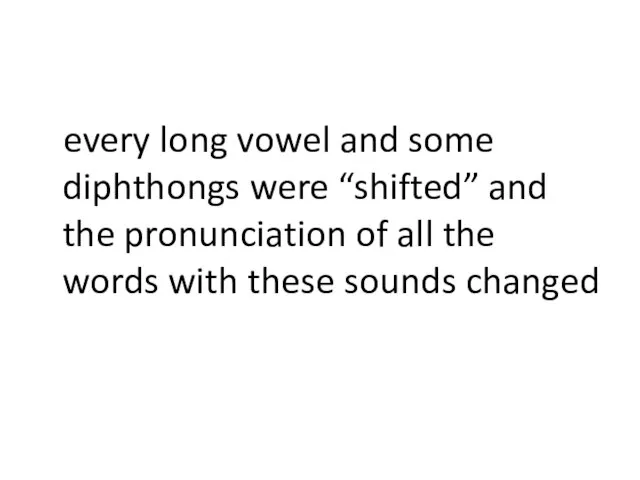
all the words with these sounds changed
Слайд 14
Changes of Short Vowels in Early NE
The short vowels were more stable
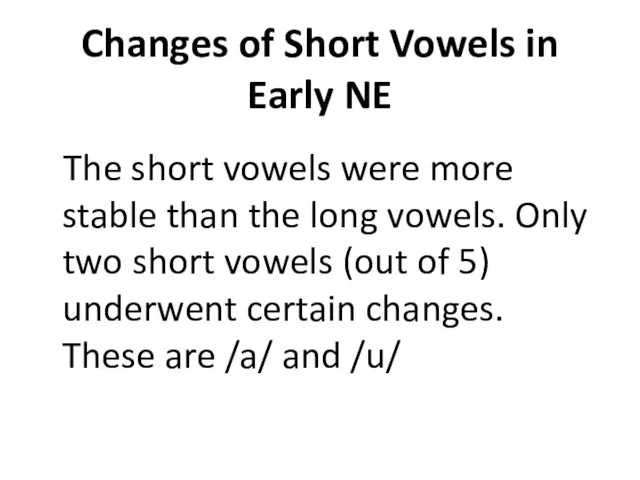
than the long vowels. Only two short vowels (out of 5) underwent certain changes. These are /a/ and /u/
Слайд 15ME /a/ normally changed into /x/
ME cat /kat/ - NE cat /kxt/
ME
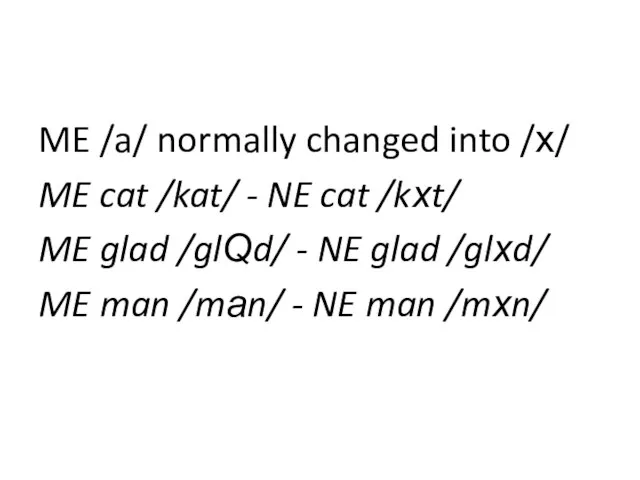
glad /glQd/ - NE glad /glxd/
ME man /man/ - NE man /mxn/
Слайд 16After /w/ sound /a/ was rounded and coincided with /O/
OE wxs >
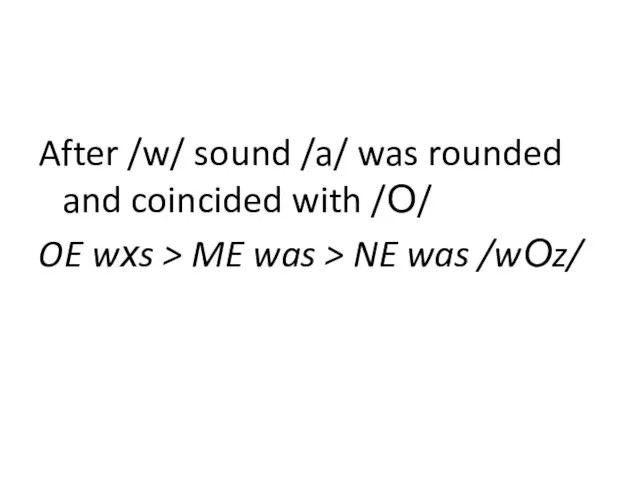
ME was > NE was /wOz/
Слайд 17Short /V/ was delabialized in the 17-th century and it developed into
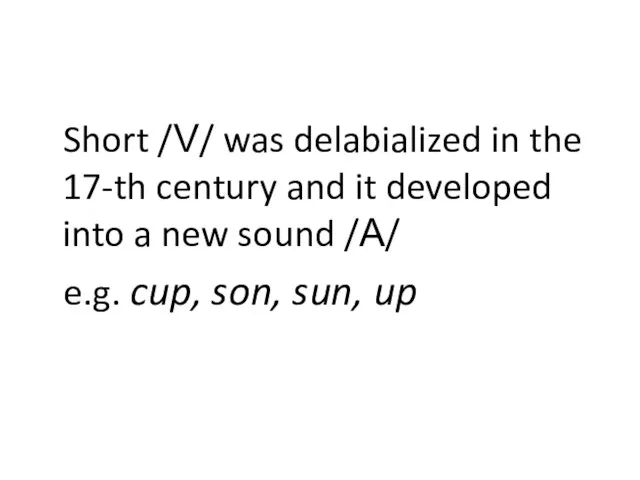
a new sound /A/
e.g. cup, son, sun, up
Слайд 18The same sound is observed in “blood, flood, mother” in which /H/
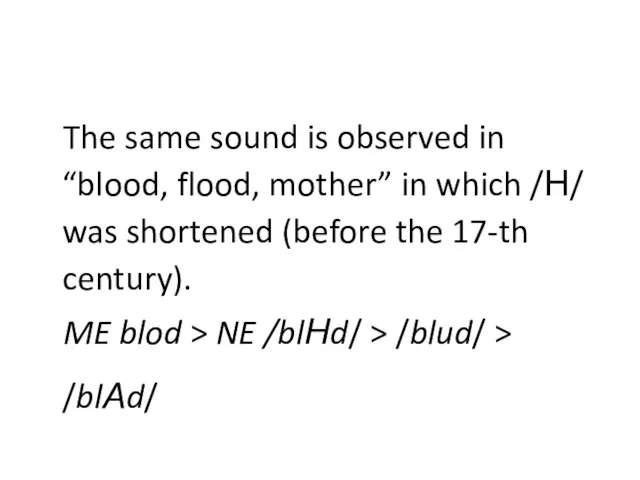
was shortened (before the 17-th century).
ME blod > NE /blHd/ > /blud/ > /blAd/
Слайд 19A preceding labial consonant usually presented the delabialization of /u/ as in:
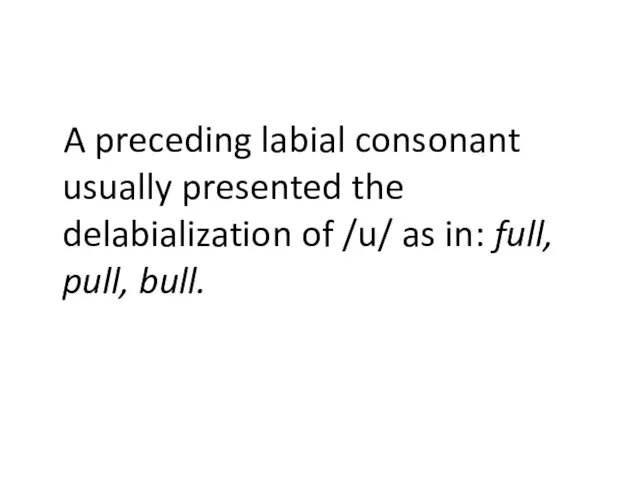
full, pull, bull.
Слайд 20
Diphthongs
ME diphthongs /aI/ and /eI/ were gradually levelled under /eI/, the spelling
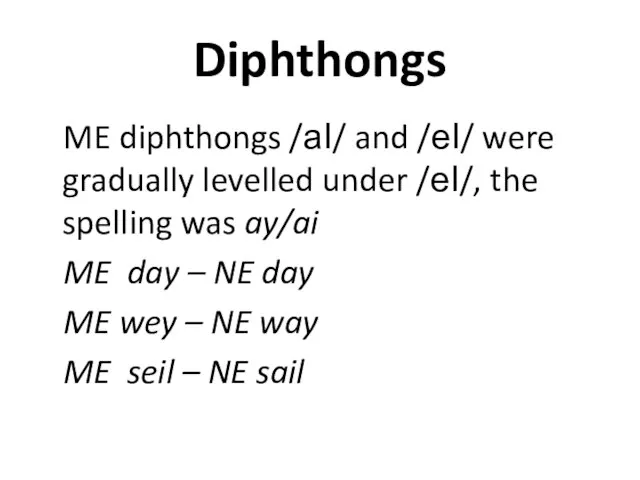
was ay/ai
ME day – NE day
ME wey – NE way
ME seil – NE sail
Слайд 21ME /aV/ was monophthongised and became /L/ as in “paw, law, cause,
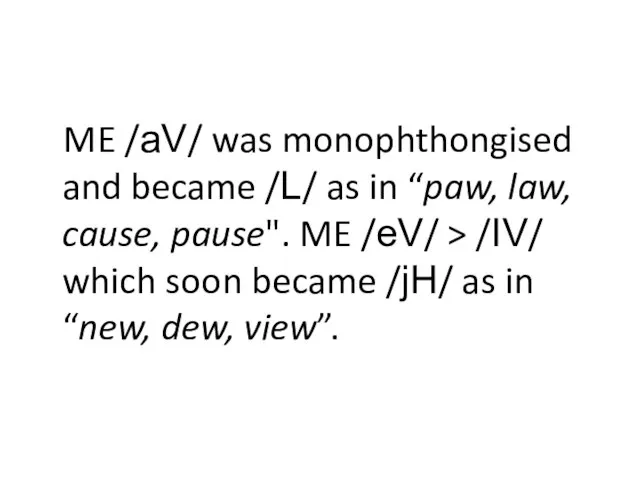
pause". ME /eV/ > /IV/ which soon became /jH/ as in “new, dew, view”.
Слайд 22The sound /u/ in French loan-words was usually replaced by /Iu/, later
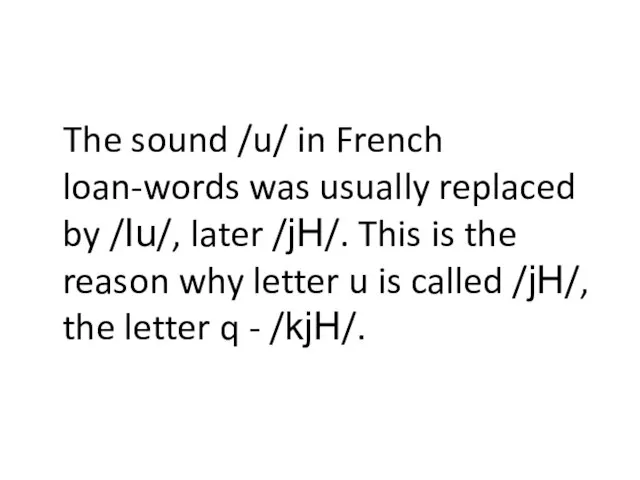
/jH/. This is the reason why letter u is called /jH/, the letter q - /kjH/.
Слайд 23
Consonants
One of the most important changes of the 15-th century was the
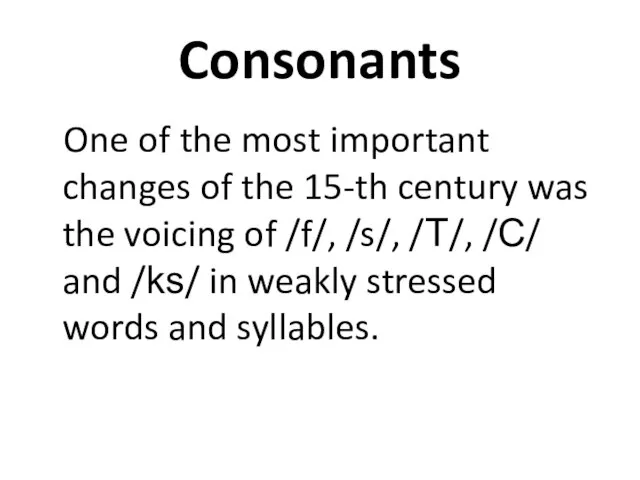
voicing of /f/, /s/, /T/, /C/ and /ks/ in weakly stressed words and syllables.
Слайд 24This phenomenon is somewhat similar to that discovered by K. Verner in
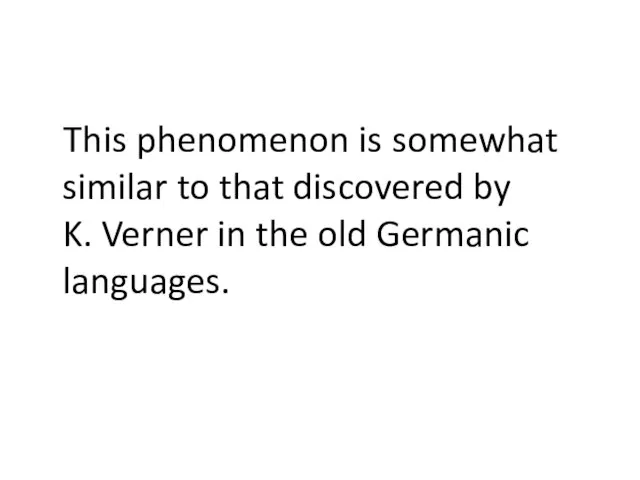
the old Germanic languages.
Слайд 25ME /f/ > /v/ “of”, active (ME actif)
ME /s/ > /z/ is,
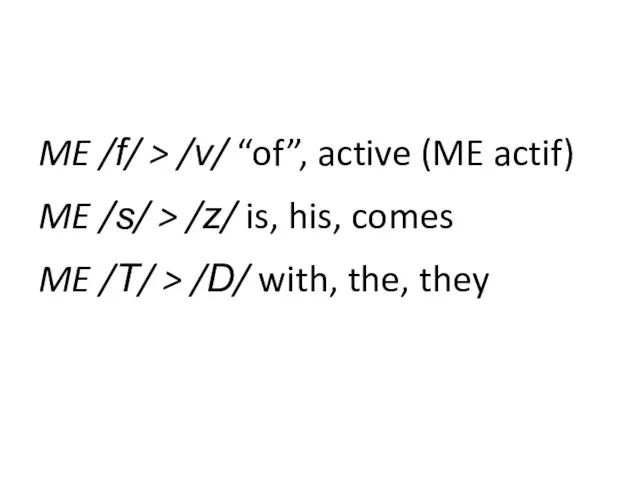
his, comes
ME /T/ > /D/ with, the, they
Слайд 26ME /C/ > /G/ knowledge
(ME knowlenche), Greenwich /'grInIG/
ME /ks/ > /gz/
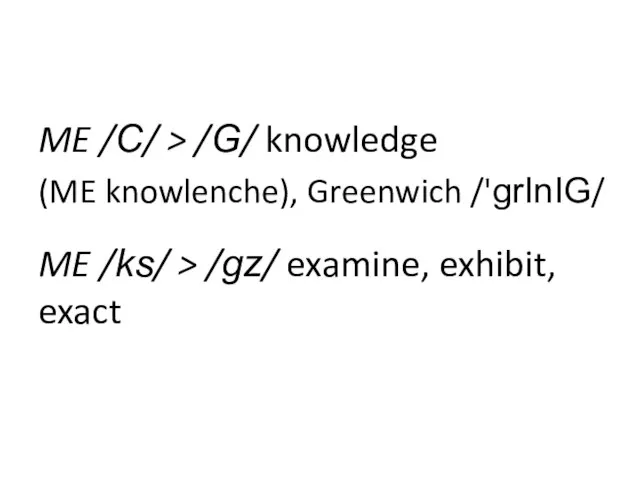
examine, exhibit, exact
Слайд 27ME /x/ (written as gh) has either been lost (mostly before /t/)
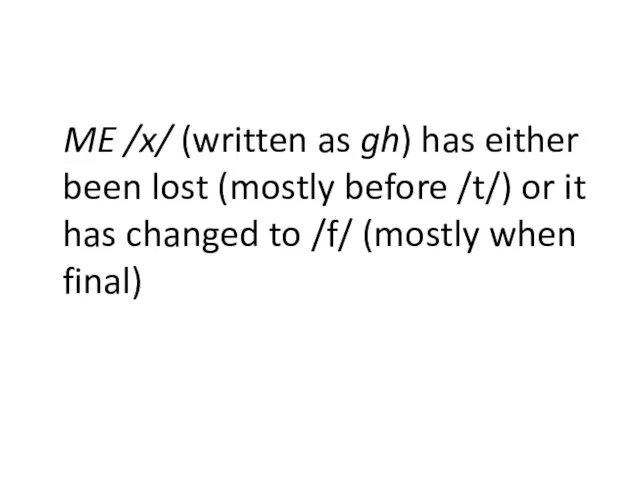
or it has changed to /f/ (mostly when final)
Слайд 28ME daughter /daVxtqr/ - E /dLtq/
eight /eixt/ - E / eit/
ME laugh
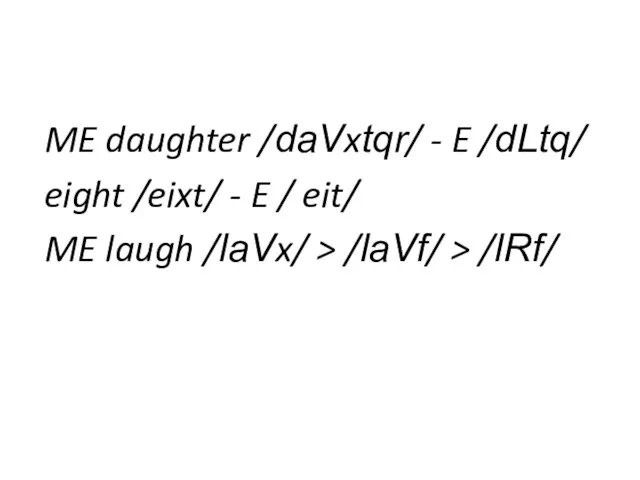
/laVx/ > /laVf/ > /lRf/
Слайд 29Short /I/ preceding /x/ was usually lengthened when the latter was lost
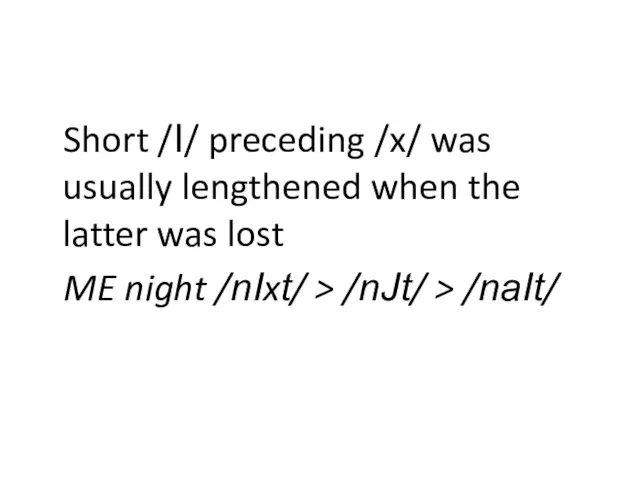
ME night /nIxt/ > /nJt/ > /naIt/
Слайд 30Final /b/ has been lost after /m/: climb, dumb, comb
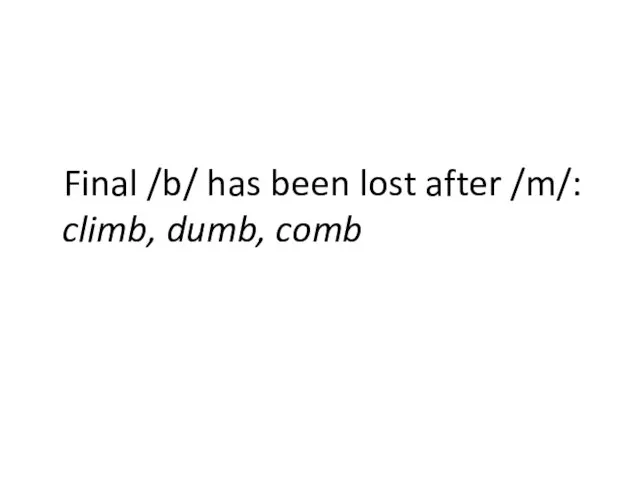
Слайд 31Final /ng/ has been reduced to /N/
ME thing /Ting/ > NE /TIN/
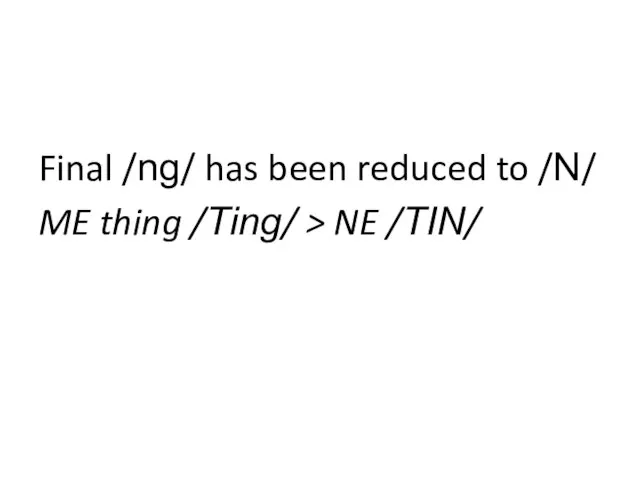
Слайд 32Initial /k/ or /g/ before /n/ and /w/ before /r/ has been
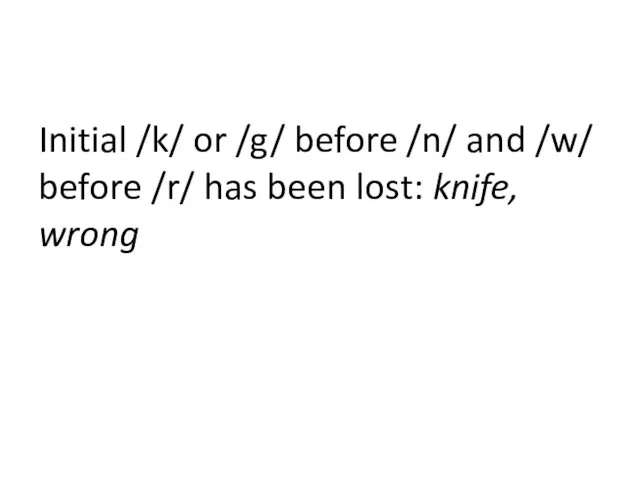
lost: knife, wrong
Слайд 33In the 15-th century /d/ before /r/ often changed into /D/:
ME
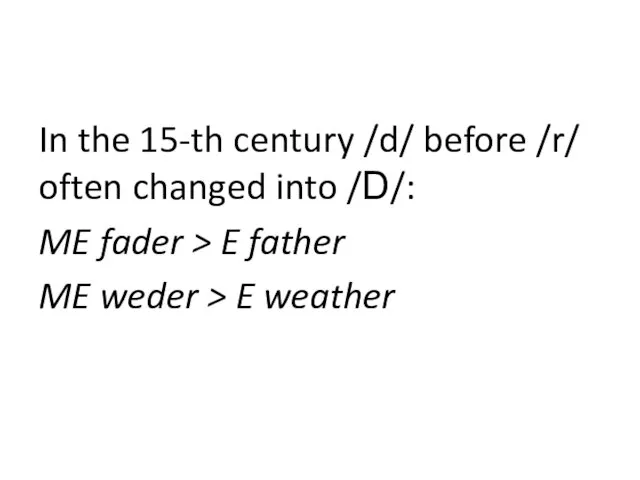
fader > E father
ME weder > E weather
Слайд 34New sibilants developed in the 17-th century from the combinations
s sj
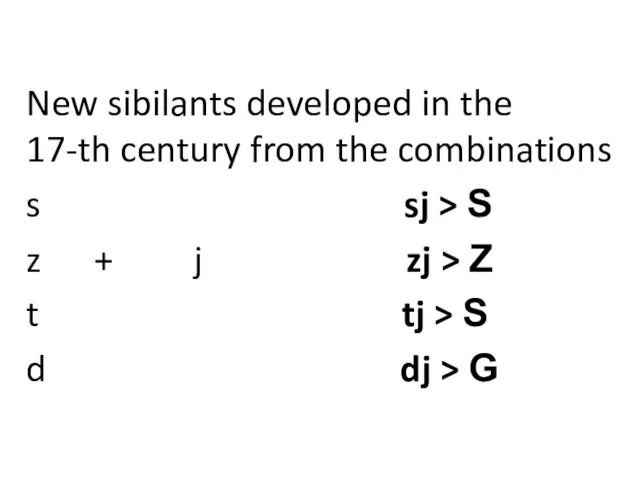
> S
z + j zj > Z
t tj > S
d dj > G

































 Введение в историю и методологию бухгалтерского учёта: зачем нам всё это? Лекция №1
Введение в историю и методологию бухгалтерского учёта: зачем нам всё это? Лекция №1 Отрасли права
Отрасли права Презентация на тему Ишемическая болезнь сердца. Стенокардия
Презентация на тему Ишемическая болезнь сердца. Стенокардия  Вариации оптической и инфракрасной прозрачности атмосферы Земли под действием космических лучей и изменение термодинамических
Вариации оптической и инфракрасной прозрачности атмосферы Земли под действием космических лучей и изменение термодинамических  Обобщающий урок по теме:«Периодический закон и периодическая система химических элементов Д. И. Менделеева.Строение атома»
Обобщающий урок по теме:«Периодический закон и периодическая система химических элементов Д. И. Менделеева.Строение атома» Методичні рекомендації щодо вивчення хімії у 2012-2013 році
Методичні рекомендації щодо вивчення хімії у 2012-2013 році Презентация на тему Магистрально-модульный принцип построения компьютера
Презентация на тему Магистрально-модульный принцип построения компьютера Результати опитування: «Оцінка стану свободи слова в місті Чернівці: погляд ЗМІ»
Результати опитування: «Оцінка стану свободи слова в місті Чернівці: погляд ЗМІ» Организации внестационарного библиотечного обслуживания
Организации внестационарного библиотечного обслуживания НЕТРАДИЦИОННЫЕ МЕТОДЫ ФОРМИРОВАНИЯ КОМПЕНСАЦИОННЫХ ПАКЕТОВ
НЕТРАДИЦИОННЫЕ МЕТОДЫ ФОРМИРОВАНИЯ КОМПЕНСАЦИОННЫХ ПАКЕТОВ Засушливые зоны умеренного пояса
Засушливые зоны умеренного пояса Анализ отрасли образования для бизнес-идеи
Анализ отрасли образования для бизнес-идеи Problems of international logistics
Problems of international logistics Квадратичная функция и квадратичные неравенства
Квадратичная функция и квадратичные неравенства Отрасли российского права
Отрасли российского права РосЭкспоПервая Всероссийская Практическая Конференция мясо-молочной индустрии«Инновации в производстве – путь к сердцу потреб
РосЭкспоПервая Всероссийская Практическая Конференция мясо-молочной индустрии«Инновации в производстве – путь к сердцу потреб Народные промыслы и ремёсла Донбасса
Народные промыслы и ремёсла Донбасса Духовные ценности моей семьи
Духовные ценности моей семьи Политическая жизнь современной России
Политическая жизнь современной России Ҡурай үҫемлеге
Ҡурай үҫемлеге ПОЗНАВАТЕЛЬНЫЕ ОГРАНИЧЕНИЯ И ПОВЕДЕНИЕ ПОТРЕБИТЕЛЯ
ПОЗНАВАТЕЛЬНЫЕ ОГРАНИЧЕНИЯ И ПОВЕДЕНИЕ ПОТРЕБИТЕЛЯ Девелоперская компания А+ Девелопмент
Девелоперская компания А+ Девелопмент Художественный мир Евдокии Суторминой
Художественный мир Евдокии Суторминой Инвентаризация кассы
Инвентаризация кассы Организация работы ресторана русской кухни на 60 посадочных мест
Организация работы ресторана русской кухни на 60 посадочных мест Презентация проекта«Рок за Любовь»
Презентация проекта«Рок за Любовь» Информационные технологии в медицине
Информационные технологии в медицине Презентация продукции ООО «ГАЗПАК»
Презентация продукции ООО «ГАЗПАК»